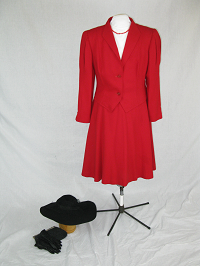1940s
By the end of the 1930s and early 1940s the world was at war again. Men went to war, women went to work on the home front. Shoulder pads and emphasis indicate 1940s for this red wool suit. Hem lines which had gotten longer in the thirties now rose again with the shortage of cloth. In 1945 the masculine look was in. Rosie the Riveter wore a head scarf and pants to work. Wide shoulders and full sleeves. 1947 launched the wasp waist, shirt waists, bolero or jacket dresses. Strapless evening gowns of the late 1940s sparked the development of combined bra and suspender belt. Short haircuts with an irregular fringe. Accessories included a black hat and veil, gloves and purse.
By the 1940s, the influence of World War II is seen in the military details of fashion. The shoulder line is now wide and padded. Bust and waist are marked, and the hip is slim. To balance the silhouette, a large-brimmed hat was worn. Throughout the war, designs were relatively unchanged, freezing the silhouette for several years, since any change in fashion would mean changes in manufacturing equipment, techniques and labor. Wool, silk, rubber, leather, nylon were needed for the war effort and were used sparingly. Skirts were limited to 72 inches with a hem depth of less than two inches. Blouses were constructed without turned back cuffs. Even men’s clothing was reduced to single breasted suit with no vests and one pair of pants, without cuffs or pleats.
Click photo for detailed view.


